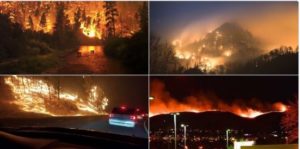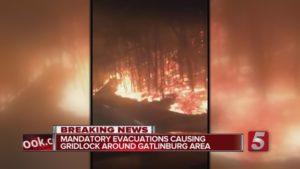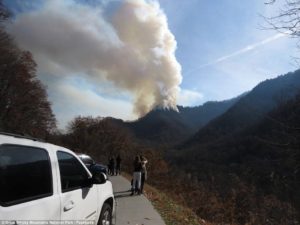By: Robert Avsec, Executive Fire Officer
The catastrophic wildfires that ravaged the mountainous areas in and around the eastern Tennessee tourist  destination towns of Pigeon Forge and Gatlinburg provide an opportunity to learn some valuable lessons about wildfires, especially those that occur in the eastern United States.
destination towns of Pigeon Forge and Gatlinburg provide an opportunity to learn some valuable lessons about wildfires, especially those that occur in the eastern United States.
Record-breaking droughts, which have already been listed as a contributing factor in the rapid development and spread of those fires, are becoming the norm. Earlier this year, NOAA and NASA jointly released their global temperature data, making it official: 2015 was the hottest year on record (since 1880). The previous hottest year was 2014, and the last time back-to-back hottest years occurred were 2006-07. In fact, the top 10 hottest years have all happened since 1998.
Tourists: A Life Safety Target Audience
One of the lessons to be learned from the eastern Tennessee fires is that fire departments and their communities can  do a better job of proactively providing emergency information to an often-overlooked target population: tourists.
do a better job of proactively providing emergency information to an often-overlooked target population: tourists.
Many areas of the U.S. depend heavily on tourism to sustain local economies; many of those same areas have taken to more aggressive marketing of their communities as vacation destinations to make up for revenues being lost through business and industry closures.
With increased tourism comes a greater life safety risk when a major emergency, like a wildfire or hurricane, threatens a resort community. While the local population may be informed, and educated based on their experience as full-time residents, tourists are living temporarily in an “unknown” land.
Other fatalities included a couple from Canada, 71-year-old Jon Tegler and 70-year-old Janet Tegler, and May Vance, who was vacationing in Gatlinburg and died of a heart attack after she was exposed to smoke. The names of the other victims have not been released (CBS News, 12/4/2016).
Strategies Fire Departments Can Use
Develop evacuation routes. Then work with local property rental companies to have those evacuation routes  posted in properties that they manage. Also, have those companies provide written copies of the evacuation route along with the rental agreement when people check in.
posted in properties that they manage. Also, have those companies provide written copies of the evacuation route along with the rental agreement when people check in.
My wife and I have visited Pigeon Forge on several occasions in the last couple of years. Like probably every other tourist, we knew one way in and one way out of Pigeon Forge: the way we came in on Day #1.
Home Fire Escape Plans. Have local property rental companies develop Home Fire Escape Plans for the dwellings that they manage and post those plans in those properties (along with the evacuation routes). One of the “cabins” that we stayed in during one of our visits to Pigeon Forge had five bedrooms, one of which was below-grade. And that was relatively small in comparison to some of the other “cabins” that we saw.
Many vacation destinations have large numbers of “McMansions”, that is, residential dwellings with a footprint of more than 4,000 square feet; these structures typically have five or more bedrooms and can be housing multiple families. All of this adds up to large numbers of people occupying a building that they’re not familiar with.
Then there’s a completely different “animal”: the multi-story condominium building. These buildings are really apartments with individual units comprised of 2-3 bedrooms, kitchen, dining area and living room area.
See Related: Apartment fire safety begins with a plan
Proactively promote your fire department’s social media presence. Use outdoor advertising, particularly along roads and highways that bring tourist into your community, to promote your Facebook Page and Twitter feed as “the source for information in the event of a major emergency during your stay in [Name of your town].”
along roads and highways that bring tourist into your community, to promote your Facebook Page and Twitter feed as “the source for information in the event of a major emergency during your stay in [Name of your town].”
Many vacation resorts have a dedicated channel on the cable or satellite TV service going into their properties which they use to marketing activities in the area, news about the resort, and other information that they believe is useful to vacationers. Get your Facebook Page and Twitter feed listed with those TV service providers and the resorts they serve.
See Related: Storms, Public Safety and Social Media
Use this opportunity to market the emergency information aspect of your social media presence, not the marketing of your fire department. Keep in mind your target audience: vacationers and tourists who know little to nothing about your community. Your purpose should be to let them know where to turn for official information if a community-wide emergency is threatening their safety.
Along those same lines, use your Facebook Page and Twitter feed to promote the presence of the evacuation routes and Home Fire Escape Plans (from Step #1 above) in their vacation accommodations.
Have any other ideas? Please post in the Comments section below for everyone’s benefit.
For more information, visit the United States Fire Administration’s webpage, Outreach Materials and Educational Programs at https://www.usfa.fema.gov/prevention/outreach/
 Fire & EMS Leader Pro The job of old firefighters is to teach young firefighters how to become old firefighters!
Fire & EMS Leader Pro The job of old firefighters is to teach young firefighters how to become old firefighters!